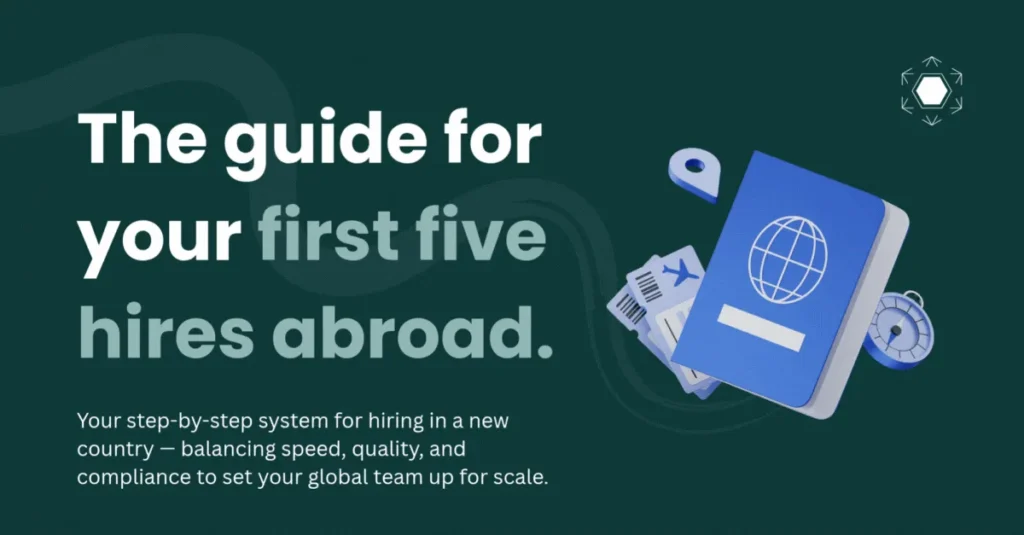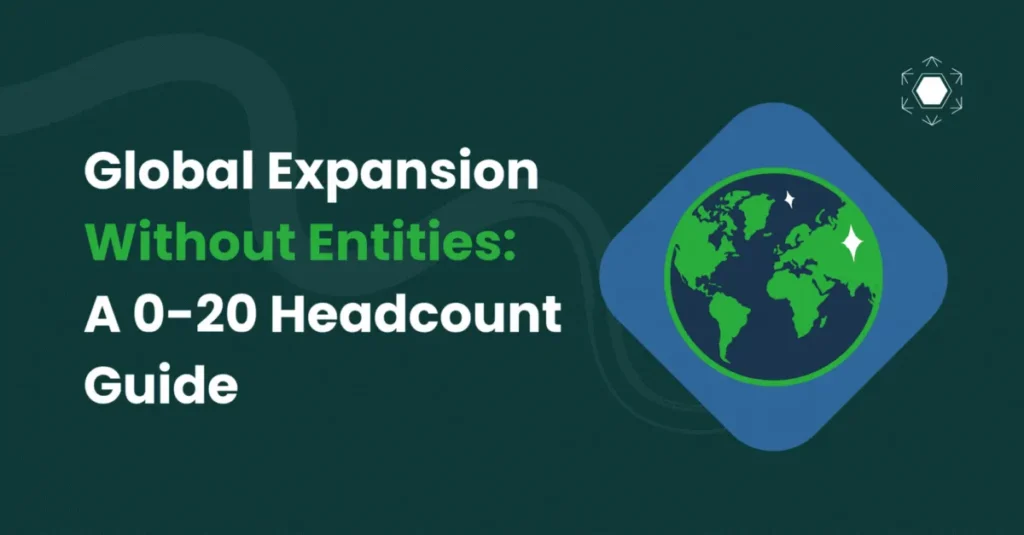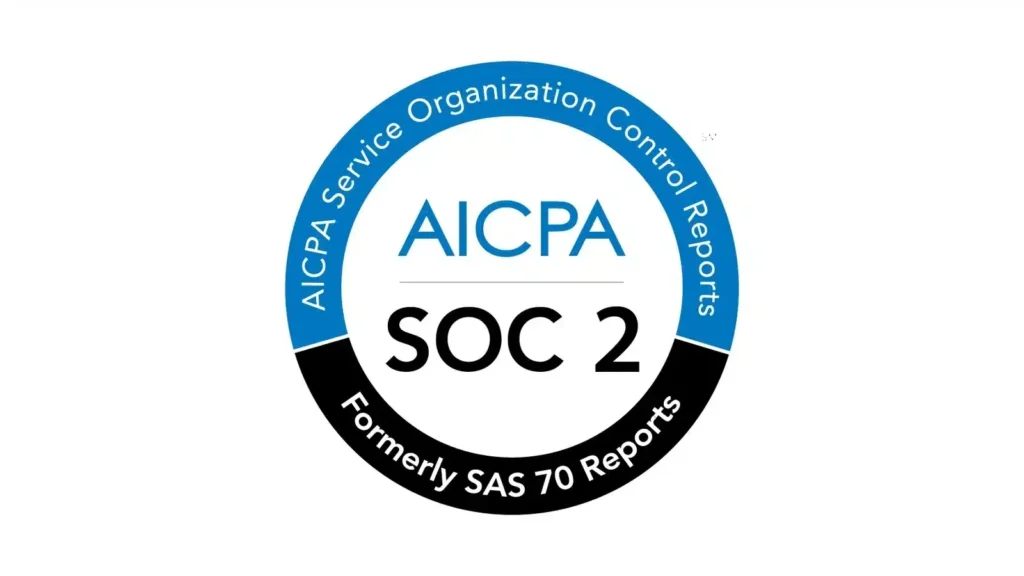Speed is only useful if quality survives contact with reality. When you’re hiring in a new country, the brief is deceptively simple: land five excellent hires fast, without drifting on compensation or lowering the bar. The hard part is doing it without a local brand, without familiar recruiting channels, and without turning the process into a committee.
This operating system gives talent leaders a proven way to move quickly and stay disciplined—the exact cadence we run with global teams opening up their first market.
In one line: start with the market, not the requisition; anchor compensation to reality before you source; run interviews on scorecards with a 48-hour decision rhythm; build trust in public; and send compliance-ready offers that start on time.
Start with the market, not the req: hiring abroad the right way
Before you write a job description, write your map. The first week is about understanding who actually does this work in your target country, where they hang out, and what they earn. Start with a short list of target companies and communities—competitors, adjacent sectors, and local hubs where the skills live. Recruiters often skip this step and jump straight into outbound. Don’t. A tight map will tell you whether you’re pricing correctly, which titles translate, and what channels will actually yield interviews in the next seven days.
Once the map is clear, tune the role to the market, not the other way round. Titles shift country to country; scope and seniority don’t have to. If your “Account Executive” is really a full-cycle closer plus some early customer success, say so plainly. Candidates forgive unfamiliar titles; they won’t forgive a surprise on responsibilities three weeks into the job.
Global compensation bands that attract top talent
The fastest way to lose great candidates is to make them guess. Publish your range early and don’t wait until the second interview to talk numbers. Bands should anchor to market medians for the country and to your internal leveling. If equity is part of the answer, explain the shape—grant size, refresh cadence, and how you think about value—so the candidate can compare apples to apples with local offers that skew toward cash.
The art is in balancing parity and sense. You don’t need to mirror HQ benefits line by line, but you do need to honour the value. Health cover, allowances, and leave are signals of belonging. When you are hiring through an Employer of Record for speed, those benefits still need to read as “us,” not as a bolt-on. That’s how you avoid compensation drift while still feeling local.
Running quality interviews fast when hiring in new markets
Interviews collapse under their own weight when everyone brings a different definition of “great.” Scorecards force clarity. Decide which four to six competencies predict success in this role—impact and execution, problem solving, communication, collaboration, plus one or two role-specific skills—and write short rubrics for what “good” looks like. Then assign owners, timebox conversations, and collect evidence rather than impressions.
The cadence matters as much as the content. Run a tight rhythm: an initial screen to align on outcomes and logistics; two core interviews that split the competencies and pressure-test the role-specific skills; a values conversation that checks how someone operates across time zones; and founder time to close. Decisions should happen within forty-eight hours of the final conversation. Fast yes, honest no, and clear feedback if you’re parking the candidate for later. The message to the market is that you respect people’s time—because you do.
Building trust when hiring internationally
You won’t have brand equity on day one, so borrow trust. Candidates want proof that your company is serious about the market and serious about them. Put a founder or senior leader in the loop early; it signals commitment and gives the candidate a direct line on vision, runway, and what success looks like. Show your work in public where it makes sense: share a short post about why you’re investing in the country, highlight a customer story, or publish a small piece of content that’s genuinely useful to the local community.
Referrals still beat ads, doubly so in new markets. Ask early hires and advisors for introductions and make it trivial to refer. Keep your outreach human and precise: why this person, why now, why this mission. When you can articulate those three, strangers reply.
Compliance-ready job offers for international hires
Momentum often dies at the last mile. Offers stall, background checks wander, and the first day slides. Keep it boring. Issue an offer that reflects the comp band you’ve already socialised, attach a clear benefits summary, and set a start date you can defend. If you’re hiring through an EOR to move quickly, say so plainly. Candidates don’t care about the administrative layer; they care that payroll and benefits will be correct from day one and that their tenure is continuous if you later graduate to a local entity.
Background checks should be lawful, proportionate, and consent-based. Not every market permits the same checks, and not every role needs the same depth. Work with a partner like Veremark so you don’t find yourself inventing a process the week before start. Immigration questions deserve the same discipline: raise them early, route to your legal team, and don’t guess. Speed and compliance are not a trade-off when you plan the offer this way.
From five to fifteen
The system that gets you your first five hires will creak as you head to fifteen. That’s the moment to formalise what worked rather than add bureaucracy for its own sake. Turn your scorecards into a lightweight interview training, publish your compensation philosophy for the country, and document the handoff from recruiting to onboarding so managers know exactly what they own on day one. If everything still relies on a heroic recruiter, you’ve built a bottleneck. If hiring feels predictable and a little bit boring, you’re ready for volume.
FAQs
How fast can we hire in a new country without losing interview quality?
Most teams can run a full process in two to three weeks if the scorecards and owners are set before sourcing starts. The secret is not more interviews; it’s faster decisions and clearer evidence.
What if the market expects very different benefits or equity?
Meet local expectations on structure while protecting value parity. You don’t have to match every perk, but you should match the intent. Explain equity in plain language and be specific about benefits so candidates can compare offers fairly.
Do we need background checks, and are they allowed?
Some checks are permitted in some places and restricted in others. Use a consent-based, role-appropriate policy and a provider like Veremark to keep it lawful and lightweight. When in doubt, ask legal before you ask the candidate.
Next step
If you want to move fast and make your first five hires in a new country without risk, we’ll run the sprint end-to-end—mapping, interviews, and compliant onboarding. Book a 30-min “first five hires” sprint plan.
Helpful links: Talent Acquisition • EOR Services • Veremark •




